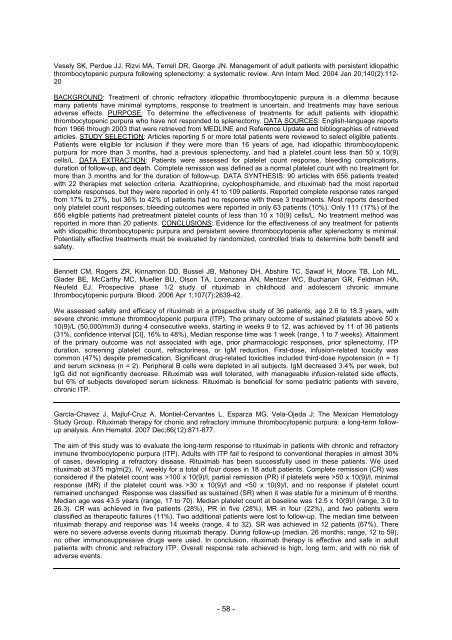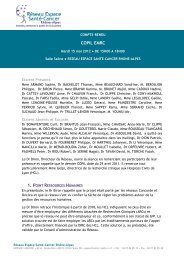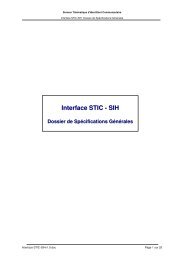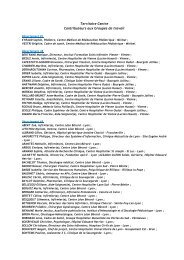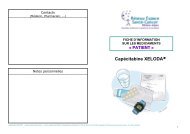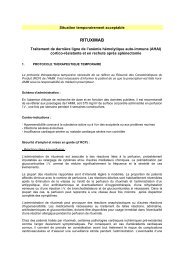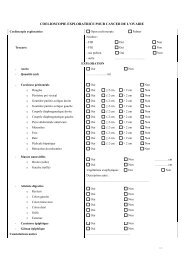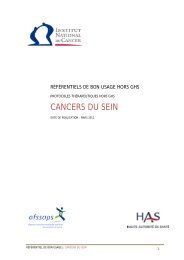rituximab
rituximab
rituximab
Create successful ePaper yourself
Turn your PDF publications into a flip-book with our unique Google optimized e-Paper software.
Vesely SK, Perdue JJ, Rizvi MA, Terrell DR, George JN. Management of adult patients with persistent idiopathicthrombocytopenic purpura following splenectomy: a systematic review. Ann Intern Med. 2004 Jan 20;140(2):112-20BACKGROUND: Treatment of chronic refractory idiopathic thrombocytopenic purpura is a dilemma becausemany patients have minimal symptoms, response to treatment is uncertain, and treatments may have seriousadverse effects. PURPOSE: To determine the effectiveness of treatments for adult patients with idiopathicthrombocytopenic purpura who have not responded to splenectomy. DATA SOURCES: English-language reportsfrom 1966 through 2003 that were retrieved from MEDLINE and Reference Update and bibliographies of retrievedarticles. STUDY SELECTION: Articles reporting 5 or more total patients were reviewed to select eligible patients.Patients were eligible for inclusion if they were more than 16 years of age, had idiopathic thrombocytopenicpurpura for more than 3 months, had a previous splenectomy, and had a platelet count less than 50 x 10(9)cells/L. DATA EXTRACTION: Patients were assessed for platelet count response, bleeding complications,duration of follow-up, and death. Complete remission was defined as a normal platelet count with no treatment formore than 3 months and for the duration of follow-up. DATA SYNTHESIS: 90 articles with 656 patients treatedwith 22 therapies met selection criteria. Azathioprine, cyclophosphamide, and <strong>rituximab</strong> had the most reportedcomplete responses, but they were reported in only 41 to 109 patients. Reported complete response rates rangedfrom 17% to 27%, but 36% to 42% of patients had no response with these 3 treatments. Most reports describedonly platelet count responses; bleeding outcomes were reported in only 63 patients (10%). Only 111 (17%) of the656 eligible patients had pretreatment platelet counts of less than 10 x 10(9) cells/L. No treatment method wasreported in more than 20 patients. CONCLUSIONS: Evidence for the effectiveness of any treatment for patientswith idiopathic thrombocytopenic purpura and persistent severe thrombocytopenia after splenectomy is minimal.Potentially effective treatments must be evaluated by randomized, controlled trials to determine both benefit andsafety.Bennett CM, Rogers ZR, Kinnamon DD, Bussel JB, Mahoney DH, Abshire TC, Sawaf H, Moore TB, Loh ML,Glader BE, McCarthy MC, Mueller BU, Olson TA, Lorenzana AN, Mentzer WC, Buchanan GR, Feldman HA,Neufeld EJ. Prospective phase 1/2 study of <strong>rituximab</strong> in childhood and adolescent chronic immunethrombocytopenic purpura. Blood. 2006 Apr 1;107(7):2639-42.We assessed safety and efficacy of <strong>rituximab</strong> in a prospective study of 36 patients, age 2.6 to 18.3 years, withsevere chronic immune thrombocytopenic purpura (ITP). The primary outcome of sustained platelets above 50 x10(9)/L (50,000/mm3) during 4 consecutive weeks, starting in weeks 9 to 12, was achieved by 11 of 36 patients(31%, confidence interval [CI], 16% to 48%). Median response time was 1 week (range, 1 to 7 weeks). Attainmentof the primary outcome was not associated with age, prior pharmacologic responses, prior splenectomy, ITPduration, screening platelet count, refractoriness, or IgM reduction. First-dose, infusion-related toxicity wascommon (47%) despite premedication. Significant drug-related toxicities included third-dose hypotension (n = 1)and serum sickness (n = 2). Peripheral B cells were depleted in all subjects. IgM decreased 3.4% per week, butIgG did not significantly decrease. Rituximab was well tolerated, with manageable infusion-related side effects,but 6% of subjects developed serum sickness. Rituximab is beneficial for some pediatric patients with severe,chronic ITP.Garcia-Chavez J, Majluf-Cruz A, Montiel-Cervantes L, Esparza MG, Vela-Ojeda J; The Mexican HematologyStudy Group. Rituximab therapy for chonic and refractory immune thrombocytopenic purpura: a long-term followupanalysis. Ann Hematol. 2007 Dec;86(12):871-877.The aim of this study was to evaluate the long-term response to <strong>rituximab</strong> in patients with chronic and refractoryimmune thrombocytopenic purpura (ITP). Adults with ITP fail to respond to conventional therapies in almost 30%of cases, developing a refractory disease. Rituximab has been successfully used in these patients. We used<strong>rituximab</strong> at 375 mg/m(2), IV, weekly for a total of four doses in 18 adult patients. Complete remission (CR) wasconsidered if the platelet count was >100 x 10(9)/l, partial remission (PR) if platelets were >50 x 10(9)/l, minimalresponse (MR) if the platelet count was >30 x 10(9)/l and


